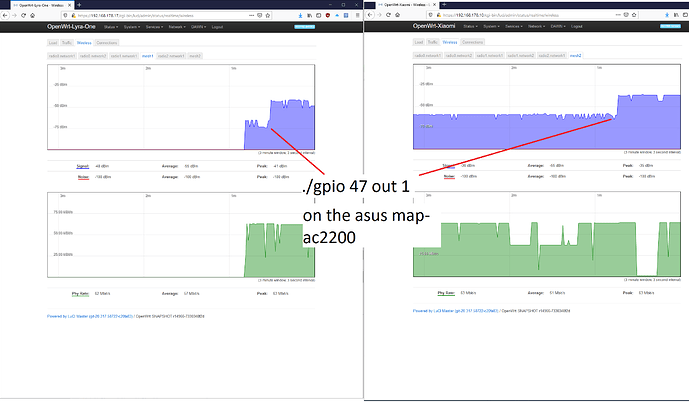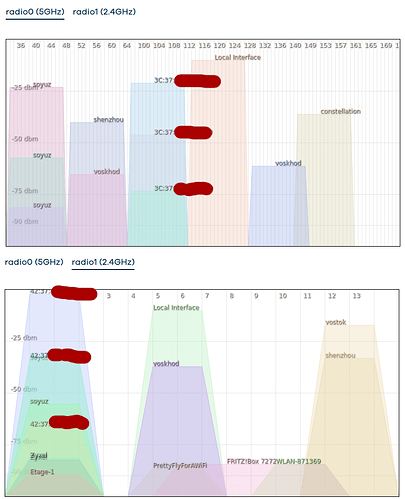Hey
I have around 15dbm lower transmit and received signal power when using OpenWRT instead of stock rom.
The APs are placed more or less at the same place.
Changing the Firmware to stock brings back the signal power expected. Changing Transmit Power is working as expected.
I tried ath10k-ct, changing the wlan country, comparing stock device-tree with OpenWRTs. Tried Openwrt 19.07 and Master.
For example the signal power received at channel 100 by a devolo 1750e from a map-ac2200 with:
Stock firmware: (Signal: -29 dBm) vs OpenWRT firmware: (Signal: -46 dBm)
Device:
Here are the scan results done with devolo.
One Asus Lyra is running with stock and the other one with openwrt.
root@OpenWrt-devolo:~# iwinfo wlan0 scan | grep -A 3 10:7B:
Asus Lyra map-ac2200 with OpenWRT and ath10k 23dbm set
Cell 03 - Address: 10:7B:XX:XX:EF:8C
ESSID: "Mywifi"
Mode: Master Channel: 36
Signal: -56 dBm Quality: 54/70
Asus Lyra map-ac2200 with Stock firmware @ 17dbm (read with iwconfig)
Cell 02 - Address: 10:7B:XX:XX:8F:AC
ESSID: "Mywifi"
Mode: Master Channel: 36
Signal: -45 dBm Quality: 65/70
Asus Lyra map-ac2200 with OpenWRT and ath10k 26dbm set
Cell 06 - Address: 10:7B:XX:XX:EF:8A
ESSID: "Mywifi"
Mode: Master Channel: 100
Signal: -46 dBm Quality: 64/70
Asus Lyra map-ac2200 with Stock firmware @ 26dbm auto (read with iwconfig)
Cell 09 - Address: 10:7B:XX:XX:8F:AA
ESSID: "Mywifi"
Mode: Master Channel: 100
Signal: -29 dBm Quality: 70/70
In 2.4Ghz WIFI works as excepted.
2.4Ghz scan from another AP:
root@OpenWrt-devolo:~# iwinfo wlan1 scan | grep -A 3 10:7B:
Asus Lyra map-ac2200 with OpenWRT and ath10k 20dbm set
Cell 13 - Address: 10:7B:XX:XX:EF:88
ESSID: "Mywifi"
Mode: Master Channel: 11
Signal: -35 dBm Quality: 70/70
Asus Lyra map-ac2200 with with Stock firmware @ 16dbm (read with wificonfig)
Cell 04 - Address: 10:7B:XX:XX:8F:A8
ESSID: "Mywifi"
Mode: Master Channel: 6
Signal: -41 dBm Quality: 69/70
Here are some receiving power comparisons.
e.g. power received from devolo AP at map-ac2200 (Stock: -50dBm vs OpenWRT: -66dBm)
10:7B:XX:XX:8F:AC______ Stock map-ac2200
10:7B:XX:XX:EF:8C______ OpenWRT map-ac2200
F4:06:XX:XX:38:95 ______ OpenWRT Devolo-1750E
This is the receiving power with OpenWRT:
root@OpenWrt-Lyra-One:~# iwinfo wlan0 scan | grep -A 3 -B 1 "Mywifi"
Cell 02 - Address: 10:7B:XX:XX:8F:AC
ESSID: "Mywifi"
Mode: Master Channel: 36
Signal: -49 dBm Quality: 61/70
Encryption: WPA2 PSK (CCMP)
--
Cell 03 - Address: F4:06:XX:XX:38:95
ESSID: "Mywifi"
Mode: Master Channel: 36
Signal: -66 dBm Quality: 44/70
This is the receiving power with Stock firmware:
Cell 02 - Address: 10:7B:XX:XX:EF:8C
ESSID:"Mywifi"
Mode:Master
Frequency:5.18 GHz (Channel 36)
Quality=94/94 Signal level=-48 dBm Noise level=-95 dBm
...
Cell 03 - Address: F4:06:XX:XX:38:95
ESSID:"Mywifi"
Mode:Master
Frequency:5.18 GHz (Channel 36)
Quality=94/94 Signal level=-50 dBm Noise level=-95 dBm
...
Wifi Power reading with Stock firmware with wificonfig
ath0 IEEE 802.11ng ESSID:"Mywifi"
Mode:Master Frequency:2.437 GHz Access Point: 10:7B:XX:XX:8F:A8
Bit Rate:400 Mb/s Tx-Power:16 dBm
RTS thr:off Fragment thr:off
Power Management:off
Link Quality=94/94 Signal level=-97 dBm Noise level=-95 dBm
Rx invalid nwid:2887 Rx invalid crypt:0 Rx invalid frag:0
Tx excessive retries:0 Invalid misc:0 Missed beacon:0
ath1 IEEE 802.11ac ESSID:"Mywifi"
Mode:Master Frequency:5.5 GHz Access Point: 10:7B:XX:XX:8F:AA
Bit Rate:866.7 Mb/s Tx-Power:26 dBm
RTS thr:off Fragment thr:off
Power Management:off
Link Quality=94/94 Signal level=-97 dBm Noise level=-95 dBm
Rx invalid nwid:282 Rx invalid crypt:0 Rx invalid frag:0
Tx excessive retries:0 Invalid misc:0 Missed beacon:0
ath2 IEEE 802.11ac ESSID:"Mywifi"
Mode:Master Frequency:5.18 GHz Access Point: 10:7B:XX:XX:8F:AC
Bit Rate:866.7 Mb/s Tx-Power:17 dBm
RTS thr:off Fragment thr:off
Power Management:off
Link Quality=94/94 Signal level=-97 dBm Noise level=-95 dBm
Rx invalid nwid:398 Rx invalid crypt:0 Rx invalid frag:0
Tx excessive retries:0 Invalid misc:0 Missed beacon:0
What can be the reason?
@slh I have seen, you own the same device. Do you have the same problems?


